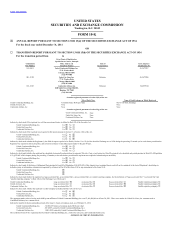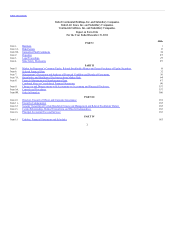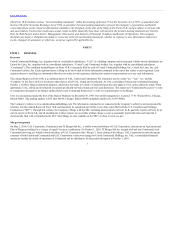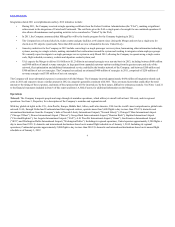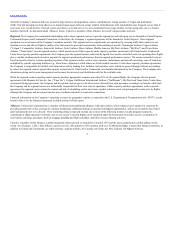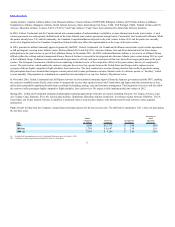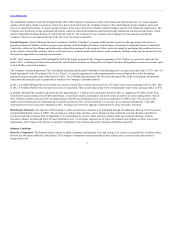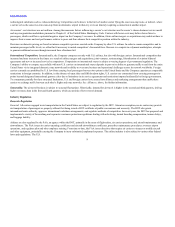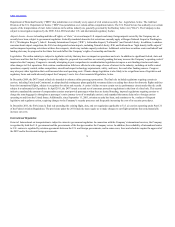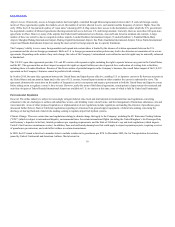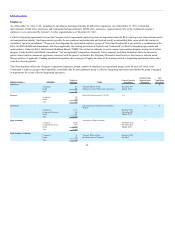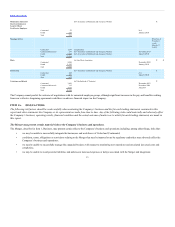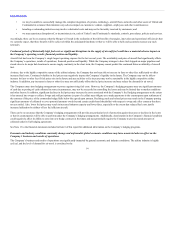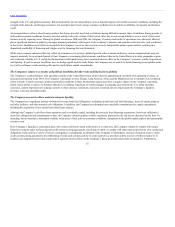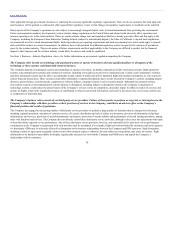United Airlines 2011 Annual Report Download - page 9
Download and view the complete annual report
Please find page 9 of the 2011 United Airlines annual report below. You can navigate through the pages in the report by either clicking on the pages listed below, or by using the keyword search tool below to find specific information within the annual report.
Table of Contents
technological substitutes such as videoconferencing. Competition can be direct, in the form of another carrier flying the exact non-stop route, or indirect, where
a carrier serves the same two cities non-stop from an alternative airport in that city or via an itinerary requiring a connection at another airport.
Air carriers’ cost structures are not uniform. Among the numerous factors influencing a carrier’s cost structure are the carrier’s chosen business/service model
and any reorganization undertaken pursuant to Chapter 11 of the United States Bankruptcy Code. Carriers with lower costs may deliver lower fares to
passengers, which could have a potential negative impact on the Company’s revenues. In addition, future airline mergers or acquisitions may enable airlines to
improve their revenue and cost performance relative to peers and thus enhance their competitive position within the industry.
Decisions on domestic pricing are based on intense competitive pressure exerted on the Company by other U.S. airlines. In order to remain competitive and to
maintain passenger traffic levels, we often find it necessary to match competitors’ discounted fares. Because we compete in a dynamic marketplace, attempts
to generate additional revenue through increased fares oftentimes fail.
International Competition. Internationally, the Company competes not only with U.S. airlines, but also with foreign carriers. International competition has
increased and may increase in the future as a result of airline mergers and acquisitions, joint ventures, restructurings, liberalization of aviation bilateral
agreements and new or increased service by competitors. Competition on international routes is subject to varying degrees of governmental regulation. The
Company’s ability to compete successfully with non-U.S. carriers on international routes depends in part on its ability to generate traffic to and from the entire
United States via its integrated domestic route network and its ability to overcome business and operational challenges across its network worldwide. Foreign
carriers currently are prohibited by U.S. law from carrying local passengers between two points in the United States and the Company experiences comparable
restrictions in foreign countries. In addition, in the absence of open skies and fifth freedom rights, U.S. carriers are constrained from carrying passengers to
points beyond designated international gateway cities due to limitations in air service agreements and restrictions imposed unilaterally by foreign governments.
To compensate partially for these structural limitations, U.S. and foreign carriers have entered into alliances and marketing arrangements that enable these
carriers to exchange traffic between each other’s flights and route networks. See above, for further information.
Seasonality. The air travel business is subject to seasonal fluctuations. Historically, demand for air travel is higher in the second and third quarters, driving
higher revenues, than in the first and fourth quarters, which are periods of lower travel demand.
Domestic Regulation
All carriers engaged in air transportation in the United States are subject to regulation by the DOT. Absent an exemption, no air carrier may provide
air transportation of passengers or property without first being issued a DOT certificate of public convenience and necessity. The DOT also grants
international route authority, approves international codeshare arrangements, and regulates methods of competition. In recent years, the DOT has proposed and
implemented a variety of far-reaching and expensive consumer protection regulations dealing with advertising, denied boarding compensation, tarmac delays,
and baggage liability.
Airlines are also regulated by the FAA, an agency within the DOT, primarily in the areas of flight safety, air carrier operations, and aircraft maintenance and
airworthiness. The FAA issues air carrier operating certificates and aircraft airworthiness certificates, prescribes maintenance procedures, oversees airport
operations, and regulates pilot and other employee training. From time to time, the FAA issues directives that require air carriers to inspect or modify aircraft
and other equipment, potentially causing the Company to incur substantial, unplanned expenses. The airline industry is also subject to various other federal
laws and regulations. The U.S.
8

